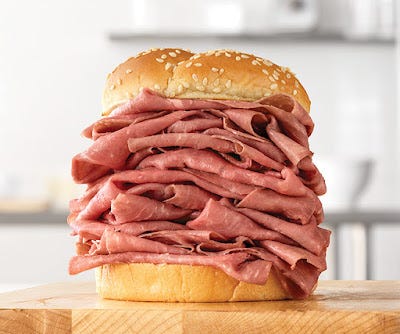By George Higginson · President & CEO at Classic Sales Consulting (1990–present)
I have been in the retail meat industry for more decades than most of the world has been alive. I was a meat cleanup, a meat cutter, meat manager, meat supervisor, meat buyer, and meat director. This encompasses every rung on the ladder from the bottom to the top. I also created (and currently create and maintain) programs that manage and maintain retail pricing in all meat categories; fresh meat, lunch meats, frozen meats, etc. Therefore, I know meat. I know the animal from which it comes, what is done with it, and I know the end product in all its many forms. I can look at any cut of meat and tell you what it is, and what it is not.
There is no doubt that Arby’s roast beef is actually beef. But, your beef sandwich is not sliced from a chunk of roast beef like top or bottom round, sirloin, etc. I will explain.
First: chicken and turkeys: when any animal is processed and the meat removed from the bone, there is inevitably a bit of meat still on the bone. Rather than lose this product, the bones go through a process that removes the remaining meat off the bone. Mixed with this salvaged meat there is also bone and connective tissue. This is done with every animal protein, including beef. However, salvaged beef is no longer used for human consumption, so breathe a sigh of relief; there is no pink slime in Arby’s beef.
Salvaged material is used in a variety of products, including hot dogs and lunch meats. A maximum of 20% slime is allowed. While mid quality turkey and chicken products are likely free of the white slime, there is no guarantee that the cheaper brands can make that claim. Whether or not slime is used, turkey or chicken is ground and mixed with liquids and seasoning, turned into slurry, and pumped into a bag that is shaped like a breast, and cooked. They look beautiful on display in your deli. They look like a real breast. Most of the time they are not. It starts out as slushy slurry, and ends up as lunch meat. It is very easy to look at a slice of turkey, chicken, or ham that you buy in a deli. If it is smooth with the occasional bit of fat and gelatin, it is a slurry product. If it has actual muscle grain through the whole slice (and not just here and there), and looks like your thanksgiving turkey breast, or a Costco chicken breast, then it is an actual piece of meat off the animal. If not, it is cooked slurry. This is what Arby’s uses for turkey sandwiches, and is the product used for any chicken or turkey lunch meats you buy at a reasonable price. If it is real whole-muscle product, it is not cheap. Just look for muscle grain to know.
Now what about Arby’s beef? Yes, it is beef. No, it is not whole-muscle roast. Therefore, it is a processed meat. Arby’s roast beef is created by mixing beef with water, salt, and sodium phosphates. It is 95% beef muscle tissue and 5% other ingredients. It is ground or otherwise masticated and turned into a slurry, pumped into a roast-shaped bag, and frozen. It is then shipped to the restaurant, where it is cooked for four hours, and sliced to order.
Update: The above paragraph conflicts with a statement from Arby’s upper management. Their statement is that the beef received in Arby’s restaurants is not a slurry, but solid beef in a bag with a gelatinous marinade. The slushy feel is attributed to the marinade. If this is true, then the only inaccuracy of my statement is that the meat may already be at least partially cooked and formed before it gets to the restaurant, instead of arriving in slurry form. However, I have also read statements from Arby’s employees who saw the product before it was cooked in-house, and it was described as mush-like ground beef mixed with small chunks of meat.
The debate may go on for as long as Arby’s exists, because they will always promote their product in the best light possible. However, regardless of whether Arby’s beef was cooked or partially cooked before or after delivery, the fact is that it is formed of ground or masticated meat, turned into a slurry, pumped into a roast-shaped bag, and cooked. Their roast beef is not whole-muscle beef, it is not a roast from a cow. It is extensively processed beef with 5% added ingredients. No statement made by Arby’s claims that they use beef roasts; they always say they use beef. It is what is left out that tells the tale. This does not necessarily mean that it is unsavory or unhealthy, it only says that it is not intact muscle tissue.
So Arby’s beef starts out as actual beef, is turned into mushy, sludgy slurry, and becomes a roast beef sandwich. The process avoids waste, and keeps costs down. Though the process may sound unappetizing when scrutinized, the end result is good enough to keep a company going since 1964.
If there are any errors in my descriptions and assertions, I am open to correction. However, please present actual facts devoid of deflection or subject to interpretation; these are industry-wide processes that have been in place for decades. The information is out there for all to see if they look.
Update: I have been informed by Dave Savage and confirmed through written FDA regulations that mechanically separated meat is now allowed again for human consumption. It is allowed in ground beef, as well as deli products such as hot dogs, bologna, and sausages. As far as I can tell, it still cannot be used in roast beef-type products, as it is classified as ground beef, but I cannot verify one way or the other. If you find a roast beef product that includes “ground beef” in the ingredients, you can be sure it is mechanically separated beef.
Another update: I’ve been asked why there is a concern with mechanically separated beef. When you consider what you are getting, it really is basically just finely ground beef (and pork & chicken). However, there are a couple of differences that will concern some shoppers with respect to the salvaged beef product:
Regular ground beef that is produced in plants can contain up to 101 ppm of ammonia. Ammonia gas is used during the production process to prevent bacterial growth, and there is a residual amount left in the beef. However, mechanically separated beef is allowed to have 200 ppm of ammonia. So I suppose the concern would be that salvaged beef has double the ammonia. It is interesting to note that one report states that regular ground beef that you buy in the store can have up to 15% of this product and still be called ground beef. This is a bit confusing because the product itself is now classified as ground beef by the USDA. This merits some investigation, but I will leave that to an enterprising author who wants to tackle the investigation.
Mechanically separated beef inevitably has some nerve tissue that is extracted with the meat. The original reason for banning the substance was the danger of contracting mad cow disease, which lives in neural tissue. It is now legal to use again, but it still contains nerve tissue. If Mad Cow ever rears it’s ugly head again, we may have serious problems.
Go paid at the $5 a month level, and we will send you both the PDF and e-Pub versions of “Government” - The Biggest Scam in History… Exposed! and a coupon code for 10% off anything in the Government-Scam.com/Store.
Go paid at the $50 a year level, and we will send you a free paperback edition of Etienne’s book “Government” - The Biggest Scam in History… Exposed! AND a 64GB Liberator flash drive if you live in the US. If you are international, we will give you a $10 credit towards shipping if you agree to pay the remainder.
Support us at the $250 Founding Member Level and get a signed high-resolution hardcover of “Government” + Liberator flash drive + Larken Rose’s The Most Dangerous Superstition + Art of Liberty Foundation Stickers delivered anywhere in the world. Our only option for signed copies besides catching Etienne @ an event.







I am a vegetarian. Mystery meat is one of my many reasons for not consuming flesh.
Is this the reason why their meat tastes funny? Am I the only person that thinks it tastes funny?